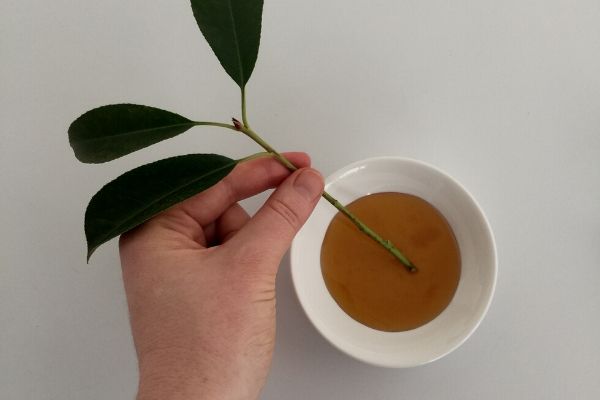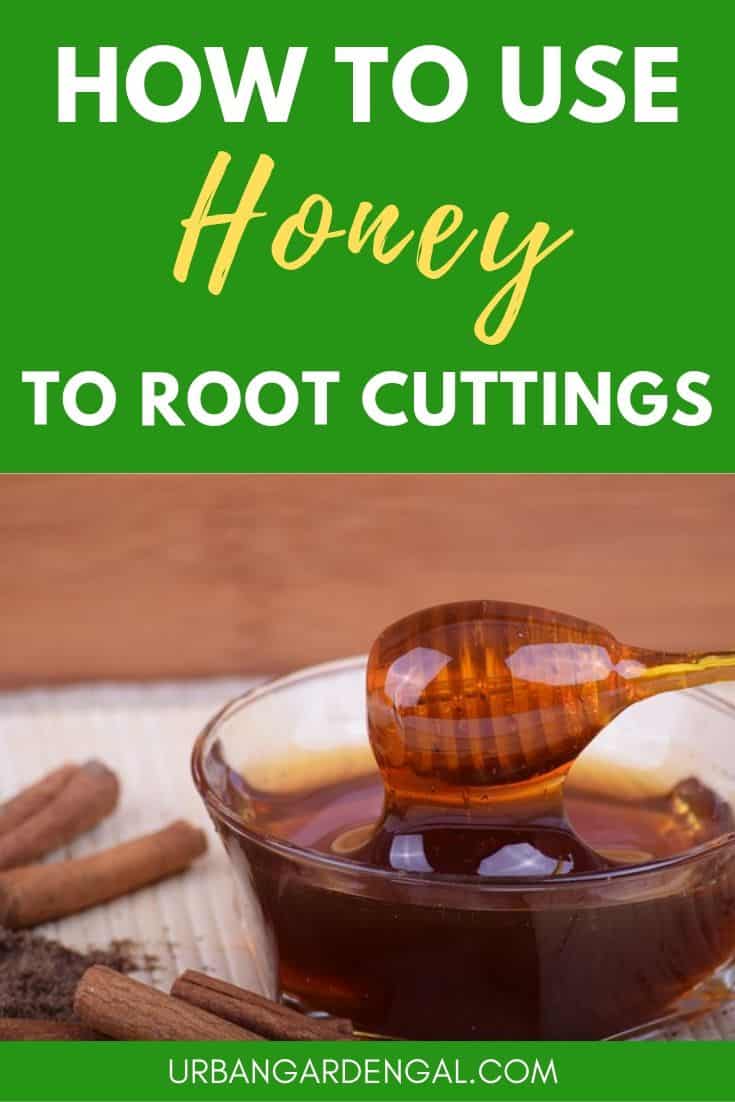How to use honey to promote root growth in cuttings
There are many synthetic rooting hormones available including liquids, powders and gels that can promote rapid root growth in cuttings, but if you’re an organic gardener or you’d just prefer a natural, chemical-free option, you should definitely consider honey as a natural rooting stimulant.
This post contains affiliate links. Please read the disclosure for more info.

The reason honey works well as a natural rooting hormone is because it has anti-bacterial and anti-fungal properties.
Honey protects the cuttings from pathogens and allows the natural rooting hormones in the cutting to stimulate root growth.
Some plants will root well on their own without the need of rooting hormones, whereas other plants need a little help.
It’s rare to achieve a 100% success rate when propagating cuttings, but rooting hormones can help to increase your chances of success.
Honey vs Synthetic Rooting Hormones
A study by the University of Hawaii’i found that honey does demonstrate an ability to root plant cuttings but it wasn’t as effective as synthetic rooting hormones. [1]
This is just one small study and although honey doesn’t have the same fast results as synthetic hormones, it can increase the success rate when propagating plants and you’ll see more consistent results than using nothing at all.
Cleanliness is also an important factor when propagating. Cleaning and sterilizing your equipment is essential for creating healthy new plants.

Honey rooting hormone recipes
Most recipes for honey rooting hormone say to mix one tablespoon of honey into two cups of boiling water, but I prefer to use the honey straight out of the jar.
The natural antibacterial and antifungal properties in honey
are destroyed when honey is heated, which is why it’s best to use raw honey. (Regular
honey from the grocery store has been heat treated, so it won’t help with
propagation).
You can also add a pinch of cinnamon to the raw honey.
Cinnamon has antibacterial and antimicrobial properties that help to protect the cutting and allows the natural rooting hormones that are found in the green growth of the cuttings to produce roots.
Which plants can be propagated with honey?
You can use honey for just about any type of cuttings including soft-wood, green-wood and hard-wood cuttings including rose, camellia, hydrangea and geranium. Even succulent cuttings can benefit from honey.
RELATED: 10 Easy To Propagate Houseplants
How to use honey for cuttings
The first step is to prepare your cuttings. Depending on the plant, the cuttings should be between 4 – 6 inches (10 – 15 cm) in length and cut on a 45-degree angle.
The best time of year to take cuttings is late spring or early summer. Cuttings taken at other times of the year can still be used, but they may take longer to form roots.
Once you have your cuttings ready, dip each cutting into the honey and then make a hole in the potting mix with your finger for each cutting.
Keep the potting media moist and you can expect roots to form in 7 – 14 days.
Succulents can be dipped in honey and placed on top of the potting soil. In a few weeks’ time, roots will start growing from the lower part of the leaves.
Honey can also be used for water propagation. Just dip the cutting in the honey and it place it straight into the water.
Once the root gets to about an inch (2 – 3 cm) in length it can be potted up.
Here’s a quick video that shows how to use honey to propagate semi-hardwood lavender cuttings. I hope you’ll find it helpful.
So there are my tips for using honey as a natural rooting hormone.
Dipping your cuttings in honey before planting can increase your propagation success rate.
RELATED ARTICLES
- How To Propagate Photinia From Cuttings
- How To Propagate Pittosporums
- How To Use Aloe Vera as a Rooting Hormone
Have you tried using honey as a natural rooting hormone? Let me know in the comments below.
Are you on Pinterest? I have boards dedicated to Propagating Plants and Gardening Tips that you may enjoy. You can also find me on Facebook.






I’m glad I found this article. I’ve started a new garden and I’m hoping to do some propagation soon but I wasn’t keen on the idea of using synthetic rooting hormone formulas filled with chemicals. I’d much rather use honey to propagate my plants and cuttings. Thanks for this really useful information.
Thanks Amelia, good luck with your propagation. I hope the honey works well for your cuttings.
I love ginkgo trees. My local nursery had one very sad looking specimen for $70! Nope, not gonna buy it. I took a cutting from a neighbor’s tree and will try and root it with the honey method. I’m not holding my breath but I would be so excited if it rooted. Thanks for the info.
Bev
Good luck with your propagation Bev! I hope your ginkgo cutting will root.
Can honey be used on a fig tree cutting?
Hi Joseph, yes you can definitely use honey to root a fig tree cutting.
Hi! What is the name of the plant in the 2nd photo? I also have one. It was gifted to me, but I was unable to find it’s name so I could search the internet for the best technique to grow it. Right now I am just doing what my instinct tells me and it has survived for more than 8 months so seems great.
Hi Carmen, that’s a photinia cutting that I propagated using honey. I’m pleased to hear that your plant is doing well.
Going to try and use this method for a hibiscus cutting I took from my neighbors bush. Bookmarked this page so I can let you know how it worked.
Good luck Steph, I hope your hibiscus cutting takes root.
Does anyone have any experience rooting sumac from clippings? I want to root and raise it indoors over the winter under a grow light. I will definitely try honey, but am debating water or potting mix.
Hi Mel, I haven’t tried rooting sumac cuttings but you could definitely give it a try with honey and potting mix. I hope your propagation is successful.
It answered my hormone rooting question
I’m going to try it with banana peppers.
Please help me I have a poinsettia that I’ve cared for for a year. Recently a window fixture fell on it and destroyed it. What can I do? It’s not totalled but can I re root the pieces I have and can l use the potato and honey treatment?
Hi Dessaiie, yes you can take some cuttings from your poinsettia, dip them in honey and place the cuttings in a pot somewhere out of direct sunlight until they take root.
I can’t figure out what plant I want to grow. I might grow a rose but can I use honey for a rose?
Hi Luna, yes you can use honey to propagate roses.
hi there! can I use honey as rooting hormone on a freshly cut plumeria cutting? the ends still need to callous but I’m unsure if I can use honey on the cutting now if it still needs to callous at the ends. thanks for your help!
Hi Jenn, it’s best to take plumeria cuttings in spring or summer. I’d let the ends callous first and then dip them in honey before potting them up.
Honey is only antibacterial/fungal if it stays undiluted. This is why Botulism is a major concern when honey is diluted and not used immediately. This is why one can make Kombucha with honey, I’ve done it despite many naysayers who evangelize honey’s many miraculous properties. The peroxidase enzymes also only activate at specific temperatures, above what would be useful in wound care.
Honey is also full of chemicals. Sugars, enzymes, water, the chemicals that pollen is made of, etc. Synthetic rooting hormones work because they are the same hormones produced by plants already. But it’s more cost effective to synthesize them rather than extract them, and the synthesized molecule is no different from the “natural” molecule synthesized by Willow, roses, cannabis, etc.
Yes, plants are chemists too.
I’m trying this method with a cutting that broke while moving them from one location to another and I have had success with indoor ivy plants and using honey to propagate them also. They bounced right back!! I also cut the leaves, leaving half the leaves on to tell the cutting to grow roots not to put the nutrients into feed and also removed any big leaves to give it more energy to root.
Hello.
I want to root my mint stem cuttings without keeping them in water.
will your honey cinnamon idea work?
Hi Tom, yes you can dip the mint cuttings in honey and pot them up. Mint is very easy to root from cuttings.
Can this method be used to propagate acer tree using honey